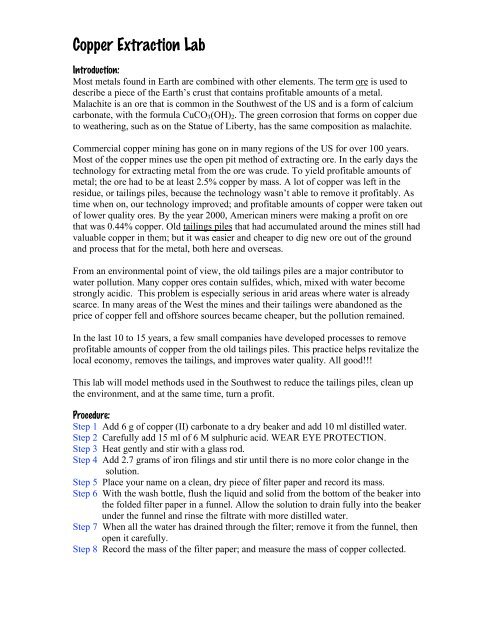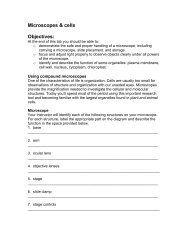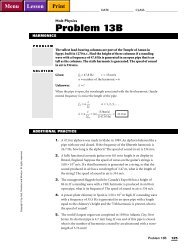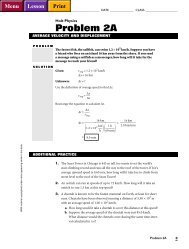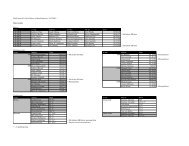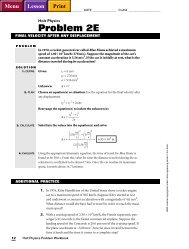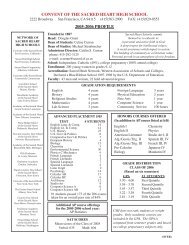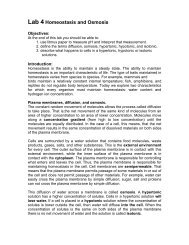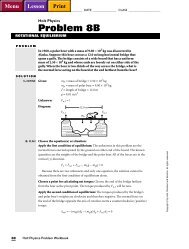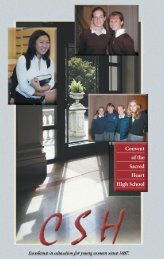Copper Extraction Lab
Copper Extraction Lab
Copper Extraction Lab
You also want an ePaper? Increase the reach of your titles
YUMPU automatically turns print PDFs into web optimized ePapers that Google loves.
<strong>Copper</strong> <strong>Extraction</strong> <strong>Lab</strong>Introduction:Most metals found in Earth are combined with other elements. The term ore is used todescribe a piece of the Earth’s crust that contains profitable amounts of a metal.Malachite is an ore that is common in the Southwest of the US and is a form of calciumcarbonate, with the formula CuCO 3 (OH) 2 . The green corrosion that forms on copper dueto weathering, such as on the Statue of Liberty, has the same composition as malachite.Commercial copper mining has gone on in many regions of the US for over 100 years.Most of the copper mines use the open pit method of extracting ore. In the early days thetechnology for extracting metal from the ore was crude. To yield profitable amounts ofmetal; the ore had to be at least 2.5% copper by mass. A lot of copper was left in theresidue, or tailings piles, because the technology wasn’t able to remove it profitably. Astime when on, our technology improved; and profitable amounts of copper were taken outof lower quality ores. By the year 2000, American miners were making a profit on orethat was 0.44% copper. Old tailings piles that had accumulated around the mines still hadvaluable copper in them; but it was easier and cheaper to dig new ore out of the groundand process that for the metal, both here and overseas.From an environmental point of view, the old tailings piles are a major contributor towater pollution. Many copper ores contain sulfides, which, mixed with water becomestrongly acidic. This problem is especially serious in arid areas where water is alreadyscarce. In many areas of the West the mines and their tailings were abandoned as theprice of copper fell and offshore sources became cheaper, but the pollution remained.In the last 10 to 15 years, a few small companies have developed processes to removeprofitable amounts of copper from the old tailings piles. This practice helps revitalize thelocal economy, removes the tailings, and improves water quality. All good!!!This lab will model methods used in the Southwest to reduce the tailings piles, clean upthe environment, and at the same time, turn a profit.Procedure:Step 1 Add 6 g of copper (II) carbonate to a dry beaker and add 10 ml distilled water.Step 2 Carefully add 15 ml of 6 M sulphuric acid. WEAR EYE PROTECTION.Step 3 Heat gently and stir with a glass rod.Step 4 Add 2.7 grams of iron filings and stir until there is no more color change in thesolution.Step 5 Place your name on a clean, dry piece of filter paper and record its mass.Step 6 With the wash bottle, flush the liquid and solid from the bottom of the beaker intothe folded filter paper in a funnel. Allow the solution to drain fully into the beakerunder the funnel and rinse the filtrate with more distilled water.Step 7 When all the water has drained through the filter; remove it from the funnel, thenopen it carefully.Step 8 Record the mass of the filter paper; and measure the mass of copper collected.
Analysis:Weight of the filter paper before:Weight of the filter paper and copper after:Mass of copper:1) It is expected that this experiment will yield 3.07 g of copper. How much did itactually yield?2) Calculate the percent change between expected and actual yield.3) Essentially we did what with copper junky waste?4) Explain how this could be used to help with the insane amount of copper tailingspiles around the Southwest?5) What was the level of difficulty associated with our conversion experiment?6) Why isn’t it done more?


